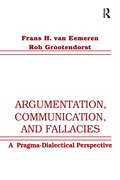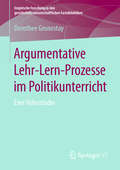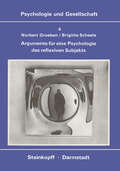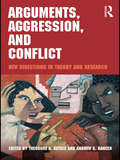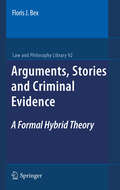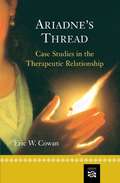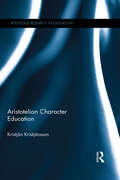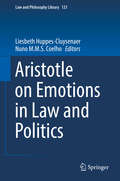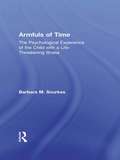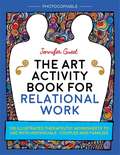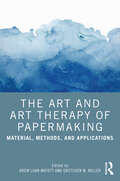- Table View
- List View
Argumentation, Communication, and Fallacies: A Pragma-dialectical Perspective
by Rob Grootendorst Frans H. van EemerenThis volume gives a theoretical account of the problem of analyzing and evaluating argumentative discourse. After placing argumentation in a communicative perspective, and then discussing the fallacies that occur when certain rules of communication are violated, the authors offer an alternative to both the linguistically-inspired descriptive and logically-inspired normative approaches to argumentation. The authors characterize argumentation as a complex speech act in a critical discussion aimed at resolving a difference of opinion. The various stages of a critical discussion are outlined, and the communicative and interactional aspects of the speech acts performed in resolving a simple or complex dispute are discussed. After dealing with crucial aspects of analysis and linking the evaluation of argumentative discourse to the analysis, the authors identify the fallacies that can occur at various stages of discussion. Their general aim is to elucidate their own pragma- dialectical perspective on the analysis and evaluation of argumentative discourse, bringing together pragmatic insight concerning speech acts and dialectical insight concerning critical discussion.
Argumentative Lehr-Lern-Prozesse im Politikunterricht: Eine Videostudie (Empirische Forschung in den gesellschaftswissenschaftlichen Fachdidaktiken)
by Dorothee GronostayDorothee Gronostay untersucht das Potential argumentativer Lehr-Lern-Prozesse im Politikunterricht (z.B. kontroverser Diskussionen) zur kognitiven Aktivierung der Schülerinnen und Schüler. In drei empirischen Teilstudien werden Sequenzmuster argumentativer Abwägung identifiziert, Wirkungen eines fachspezifischen Argumentationstrainings auf die Diskussionsqualität geprüft sowie Effekte von Persönlichkeitsmerkmalen und zugewiesenen Diskussionspositionen (pro/kontra) auf die Diskussionsbeteiligung und persönliche Position der Schülerinnen und Schüler zu einer politischen Streitfrage untersucht. Die Autorin stellt vielfältige Bezüge zur Unterrichtspraxis her und leitet aus den Ergebnissen auch unterrichtspraktische Implikationen ab.
Argumente für eine Psychologie des Reflexiven Subjekts: Paradigmawechsel vom behavioralen zum epistemologischen Menschenbild (Psychologie und Gesellschaft #4)
by N. Groeben B. ScheeleArguments, Aggression, and Conflict: New Directions in Theory and Research
by Theodore A. AvtgisArguments, Aggression, and Conflict provides a thorough examination of argumentative and aggressive communication. Editors Theodore A. Avtgis and Andrew S. Rancer bring together a score of prolific and informed authors to discuss aspects of the conceptualization and measurement of aggressive communication. The book features an exclusive focus on two "aggressive communication" traits: argumentativeness and verbal aggressiveness, one of the most dominant areas of communication research over the last twenty five years both nationally and internationally. The chapters include cutting-edge issues in the field and present new ideas for future research. This book is a valuable resource for instructors, researchers, scholars, theorists, and graduate students in communication studies and social psychology. Covering a variety of topics, from the broad-based (e.g. new directions in aggressive communication in the organizational context) to the more specific (e.g. verbal aggression in sports), this text presents a comprehensive compilation of essays on aggressive communication and conflict.
Arguments, Aggression, and Conflict: New Directions in Theory and Research
by Theodore Avtgis Andrew S. RancerArguments, Aggression, and Conflict provides a thorough examination of argumentative and aggressive communication. Editors Theodore A. Avtgis and Andrew S. Rancer bring together a score of prolific and informed authors to discuss aspects of the conceptualization and measurement of aggressive communication. The book features an exclusive focus on two "aggressive communication" traits: argumentativeness and verbal aggressiveness, one of the most dominant areas of communication research over the last twenty five years both nationally and internationally. The chapters include cutting-edge issues in the field and present new ideas for future research. This book is a valuable resource for instructors, researchers, scholars, theorists, and graduate students in communication studies and social psychology. Covering a variety of topics, from the broad-based (e.g. new directions in aggressive communication in the organizational context) to the more specific (e.g. verbal aggression in sports), this text presents a comprehensive compilation of essays on aggressive communication and conflict.
Arguments, Stories and Criminal Evidence: A Formal Hybrid Theory (Law and Philosophy Library #92)
by Floris J. BexIn this book a theory of reasoning with evidence in the context of criminal cases is developed. The main subject of this study is not the law of evidence but rather the rational process of proof, which involves constructing, testing and justifying scenarios about what happened using evidence and commonsense knowledge. A central theme in the book is the analysis of ones reasoning, so that complex patterns are made more explicit and clear. This analysis uses stories about what happened and arguments to anchor these stories in evidence. Thus the argumentative and the narrative approaches from the research in legal philosophy and legal psychology are combined. Because the book describes its subjects in both an informal and a formal style, it is relevant for scholars in legal philosophy, AI, logic and argumentation theory. The book can also appeal to practitioners in the investigative and legal professions, who are interested in the ways in which they can and should reason with evidence.
Ariadne's Thread: Case Studies in the Therapeutic Relationship
by Eric W. CowanThis casebook provides a personal account of the struggles a counselor encounters in everyday clinical practice. Each of the eight studies--thoughtfully detailed by Dr. Cowan from his own experience--illuminates the therapist/client relationship. Follow-up discussions tie each case and the therapist's technique to counseling theory and practice. A final conclusion links all cases and the related discourse together.
Aristotelian Character Education (Routledge Research in Education)
by Kristján KristjánssonThis book provides a reconstruction of Aristotelian character education, shedding new light on what moral character really is, and how it can be highlighted, measured, nurtured and taught in current schooling. Arguing that many recent approaches to character education understand character in exclusively amoral, instrumentalist terms, Kristjánsson proposes a coherent, plausible and up-to-date concept, retaining the overall structure of Aristotelian character education.After discussing and debunking popular myths about Aristotelian character education, subsequent chapters focus on the practical ramifications and methodologies of character education. These include measuring virtue and morality, asking whether Aristotelian character education can salvage the effects of bad upbringing, and considering implications for teacher training and classroom practice. The book rejuvenates time-honoured principles of the development of virtues in young people, at a time when ‘character’ features prominently in educational agendas and parental concerns over school education systems.Offering an interdisciplinary perspective which draws from the disciplines of education, psychology, philosophy and sociology, this book will appeal to researchers, academics and students wanting a greater insight into character education.
Aristotelian Character Education (Routledge Research in Education)
by Kristján KristjánssonThis book provides a reconstruction of Aristotelian character education, shedding new light on what moral character really is, and how it can be highlighted, measured, nurtured and taught in current schooling. Arguing that many recent approaches to character education understand character in exclusively amoral, instrumentalist terms, Kristjánsson proposes a coherent, plausible and up-to-date concept, retaining the overall structure of Aristotelian character education.After discussing and debunking popular myths about Aristotelian character education, subsequent chapters focus on the practical ramifications and methodologies of character education. These include measuring virtue and morality, asking whether Aristotelian character education can salvage the effects of bad upbringing, and considering implications for teacher training and classroom practice. The book rejuvenates time-honoured principles of the development of virtues in young people, at a time when ‘character’ features prominently in educational agendas and parental concerns over school education systems.Offering an interdisciplinary perspective which draws from the disciplines of education, psychology, philosophy and sociology, this book will appeal to researchers, academics and students wanting a greater insight into character education.
Aristotle on Emotions in Law and Politics (Law and Philosophy Library #121)
by Liesbeth Huppes-Cluysenaer Nuno M.M.S. CoelhoIn this book, experts from the fields of law and philosophy explore the works of Aristotle to illuminate the much-debated and fascinating relationship between emotions and justice. Emotions matter in connection with democracy and equity – they are relevant to the judicial enforcement of rights, legal argumentation, and decision-making processes in legislative bodies and courts. The decisive role that emotions, feelings and passions play in these processes cannot be ignored – not even by those who believe that emotions have no legitimate place in the public sphere. A growing body of literature on these topics recognizes the seminal insights contributed by Aristotle. This book offers a comprehensive analysis of his thinking in this context, as well as proposals for inspiring dialogues between his works and those written by a selection of modern and contemporary thinkers. As such, the book offers a valuable resource for students of law, philosophy, rhetoric, politics, ethics and history, but also for readers interested in the ongoing debate about legal positivism and the relevance of emotions for legal and political life in today’s world.
Armfuls of Time: The Psychological Experience of the Child with a Life-Threatening Illness
by Barbara M. Sourkes'I just wish I had armfuls of time.' These are the poignant words of a four year old facing a life-threatening illness. Armfuls of Time eloquently portrays the psychological experience of such children, who are irreversibly changed from the moment of diagnosis. Barbara M. Sourkes, Ph.D. describes how she works with these children, using drawings, soft toys and dolls, stories and real medical objects, to allow them to communicate their feelings about the treatment they undergo, their relationship with their families, their experience of the illness and living with the threat of loss. Making extensive use of the words of children, offering astute interpretations and sound practical advice, this is a book that will be welcomed by all those concerned with the care of children with life-threatening illnesses.
Armfuls of Time: The Psychological Experience of the Child with a Life-Threatening Illness
by Barbara M. Sourkes'I just wish I had armfuls of time.' These are the poignant words of a four year old facing a life-threatening illness. Armfuls of Time eloquently portrays the psychological experience of such children, who are irreversibly changed from the moment of diagnosis. Barbara M. Sourkes, Ph.D. describes how she works with these children, using drawings, soft toys and dolls, stories and real medical objects, to allow them to communicate their feelings about the treatment they undergo, their relationship with their families, their experience of the illness and living with the threat of loss. Making extensive use of the words of children, offering astute interpretations and sound practical advice, this is a book that will be welcomed by all those concerned with the care of children with life-threatening illnesses.
Arnheim, Gestalt and Art: A Psychological Theory
by Ian VerstegenArnheim, Gestalt and Art is the first book-length discussion of the powerful thinking of the psychologist of art, Rudolf Arnheim. Written as a complete overview of Arnheim’s thinking, it covers fundamental issues of the importance of psychological discussion of the arts, the status of gestalt psychology, the various sense modalities and media, and developmental issues. By proceeding in a direction from general to specific and then proceeding through dynamic processes as they unfold in time (creativity, development, etc.), the book discovers an unappreciated unity to Arnheim’s thinking. Not content to simply summarize Arnheim’s theory, however, Arnheim, Art, and Gestalt goes on to enrich (and occasionally question) Arnheim’s findings with the contemporary results of gestalt-theoretical research from around the world, but especially in Italy and Germany. The result is a workable overview of the psychology of art with bridges built to contemporary research, making Arnheim’s approach living and sustainable.
Arnold and Boggs's Interpersonal Relationships - E-Book: Professional Communication Skills for Canadian Nurses
by Claire Mallette Olive June Young Elizabeth C. Arnold Kathleen Underman BoggsEngaging, comprehensive coverage presents the most current issues and communication concepts. Fully adapted content reflects Canada’s unique health care context and cultural landscape. Canadian statistics, research, references and resources, guidelines, assessment and screening tools, and more are incorporated throughout the text. Canadian cultural and demographic considerations address issues related to race/ethnicity, Indigenous peoples, gender identity, LGBTQ2 community, family composition, recent immigrants, refugees, and vulnerable persons. Engaging with Humility: Authentic Interpersonal Communication in Partnership with Indigenous Peoples chapter increases awareness and knowledge of the impact of colonization on Indigenous peoples, in order to understand and develop practices which respectfully engage in cultural safety and humility through holistic communication with Indigenous peoples and communities. Rich art programme reflects Canada’s cultural diversity in the health care setting. Emphasis on collaborative communication includes related evidence-informed case studies and analysis. Socio-cultural communication competencies coverage discusses how to reduce health disparities and increase health literacy. Questions for Review and Discussion help students practise their reflective analysis skills and provide opportunities for thoughtful review of chapter content. Content on social media and transitional care delivery reflects current practice standards. Simulation exercises enable students to practise, observe, and critically evaluate their professional communication skills in a safe learning environment. Case examples help students learn to develop empathy for patients’ perspectives and needs. Discussion of spirituality and end-of-life needs focuses on trust, empathy, and the nurse-patient relationship — all central components of holistic nursing. Nursing, behavioural, developmental, family, and communication theories provide an essential foundation and a theoretical perspective for effective communication. Ethical Dilemma boxes with reflection questions at the end of each chapter help students absorb and retain key ethical content throughout the text. Evidence-Informed Nursing Practice boxes in each chapter offer a summary of research findings related to the chapter subject and are intended to strengthen awareness of the link between research and practice. Separate chapters on communication across the lifespan highlight crucial communication tools that are the first step in developing a culture of safety in contemporary health care delivery.
Arriving Late: The lived experience of women receiving a late autism diagnosis
by Jodi Lamanna"The stories within this book tell of the journey women take to late autism diagnosis: stories of discovery, strength, self-awareness and belonging."An honest and eye-opening collection of stories from the lives of late diagnosed autistic women across the world, brought together with thoughtful observations from neurodivergent advocate, Jodi Lamanna. Exploring life before and after diagnosis and covering topics such as masking, social interaction, parenting and employment, this book provides much-needed insight into the challenges and successes of late diagnosed women. With chances for reflection on your own experiences, informative diagnosis tips and guidance on what can be done in the future to properly support autistic women, this is an essential read for late diagnosed women and those supporting them.
Arrogance: Developmental, Cultural, and Clinical Realms
by Salman Akhtar Ann SmolenArrogance as a specific constellation of affect, fantasy, and behavior has received little attention in psychoanalysis. This is striking in light of the enormous amount of literature accumulated on the related phenomenon of narcissism. Rectifying this omission, the book in your hands addresses arrogance from multiple perspectives. Among the vantage points employed are psychoanalysis, evolutionary psychology, cross-cultural anthropology, fiction, as well as clinical work with children and adults. The result is a harmonious gestalt of insight that is bound to enhance the clinician's attunement to the covert anguish of those afflicted with arrogance.
Arrogance: Developmental, Cultural, and Clinical Realms
by Salman Akhtar Ann SmolenArrogance as a specific constellation of affect, fantasy, and behavior has received little attention in psychoanalysis. This is striking in light of the enormous amount of literature accumulated on the related phenomenon of narcissism. Rectifying this omission, the book in your hands addresses arrogance from multiple perspectives. Among the vantage points employed are psychoanalysis, evolutionary psychology, cross-cultural anthropology, fiction, as well as clinical work with children and adults. The result is a harmonious gestalt of insight that is bound to enhance the clinician's attunement to the covert anguish of those afflicted with arrogance.
Art: Sublimation or Symptom
by Parveen AdamsEach of the contributors addresses the theoretical questions by pursuing a definite artistic problem, including a close look at the relation between the image and the object in Hitchcock's Vertigo, the sexual aesthetics of Caravaggio, the artistic pen of Barthes, and how Cronenberg's film Crash functions as a sinthome.
Art: Sublimation or Symptom (Contemporary Theory Ser.)
by Parveen AdamsEach of the contributors addresses the theoretical questions by pursuing a definite artistic problem, including a close look at the relation between the image and the object in Hitchcock's Vertigo, the sexual aesthetics of Caravaggio, the artistic pen of Barthes, and how Cronenberg's film Crash functions as a sinthome.
The Art Activity Book for Psychotherapeutic Work: 100 Illustrated CBT and Psychodynamic Handouts for Creative Therapeutic Work (PDF)
by Jennifer GuestHelp clients to raise self-esteem, cope with change and adversity and manage complex emotions with these brand new 100 ready-to-use illustrated worksheets and activities. Drawing on psychotherapeutic approaches including cognitive behavioural therapy (CBT), these worksheets are ideal for use in therapeutic work, for starting conversations and addressing problems that clients face. Each worksheet is designed to encourage clients to express their thoughts and emotions creatively in a relaxed way. The book also includes activities that centre on visual diary keeping, to help clients gain perspective on their unique issues and learn to solve their problems in a positive, healthy way. Suitable for adults and young people, in individual or group work, this is an excellent resource for those who work in therapy, counselling and social work.
The Art Activity Book for Relational Work: 100 illustrated therapeutic worksheets to use with individuals, couples and families (PDF)
by Jennifer GuestExplore and promote positive relationships with these 100 ready-to-use illustrated worksheets and activities. Based on systemic theory, psychodynamic theory and cognitive behavioural therapy (CBT) principles, the activities are a creative approach to starting therapeutic conversations and engaging clients in their search for solutions. The photocopiable worksheets encourage clients to express their feelings through drawing, painting and writing. They are structured around four key areas: sense of self; partner relationships; family dynamics; and improving communication and conflict resolution. Activities include explanations of how and why they help to address specific relational issues. Suitable for use by professionals working with individuals, couples or families in therapeutic situations, The Art Activity Book for Relational Work will help clients to resolve relational issues and strengthen bonds.
The Art Activity Book for Relational Work: 100 illustrated therapeutic worksheets to use with individuals, couples and families (PDF)
by Jennifer GuestExplore and promote positive relationships with these 100 ready-to-use illustrated worksheets and activities. Based on systemic theory, psychodynamic theory and cognitive behavioural therapy (CBT) principles, the activities are a creative approach to starting therapeutic conversations and engaging clients in their search for solutions. The photocopiable worksheets encourage clients to express their feelings through drawing, painting and writing. They are structured around four key areas: sense of self; partner relationships; family dynamics; and improving communication and conflict resolution. Activities include explanations of how and why they help to address specific relational issues. Suitable for use by professionals working with individuals, couples or families in therapeutic situations, The Art Activity Book for Relational Work will help clients to resolve relational issues and strengthen bonds.
The Art and Art Therapy of Papermaking: Material, Methods, and Applications
by Drew Luan Matott Gretchen M. MillerThe Art and Art Therapy of Papermaking: Material, Methods, and Applications provides a comprehensive collection about the contemporary practices, media, and value of hand papermaking as social engagement, art therapy, and personal voice. Divided into three parts that highlight each of these areas, contributors explore topics such as advocacy, work with survivors, community outreach, medical challenges, and how papermaking can empower creative expression, stories of change, recovery, and reclamation to address trauma, grief and loss, social action, and life experiences. Previous books have covered hand papermaking or art therapy media as stand-alone subjects; this text is the first of its kind that unites and describes the convergence of papermaking in all these forms. Art therapists, art educators, and artists will find this book essential to their education about how papermaking can be a powerful process to make meaning for the self, groups, and community.
The Art and Art Therapy of Papermaking: Material, Methods, and Applications
The Art and Art Therapy of Papermaking: Material, Methods, and Applications provides a comprehensive collection about the contemporary practices, media, and value of hand papermaking as social engagement, art therapy, and personal voice. Divided into three parts that highlight each of these areas, contributors explore topics such as advocacy, work with survivors, community outreach, medical challenges, and how papermaking can empower creative expression, stories of change, recovery, and reclamation to address trauma, grief and loss, social action, and life experiences. Previous books have covered hand papermaking or art therapy media as stand-alone subjects; this text is the first of its kind that unites and describes the convergence of papermaking in all these forms. Art therapists, art educators, and artists will find this book essential to their education about how papermaking can be a powerful process to make meaning for the self, groups, and community.
Art and Art Therapy with the Imprisoned: Re-Creating Identity
by David GussakThrough the author’s experiences, investigations and discussions with artists, art therapists and inmates from around the world, Art and Art Therapy with the Imprisoned: Re-Creating Identity comprehensively explores the efficacy, methods, and outcomes of art and art therapy within correctional settings. The text begins with a theoretical and historical overview of art in prisons as a precursor to exploring the benefits of art therapy, followed by a deeper exploration of art therapy as a primary focus for wellness and mental health inside penitentiaries. Relying on several theoretical perspectives, results of empirical research studies, and case vignettes and illustrations gleaned from over 25 years of clinical and programmatic experience, this book argues why art therapy is so beneficial within prisons. This comprehensive guide is essential reading for professionals in the field, as well as students of sociology, criminology, art theory, art therapy, and psychology who wish to explore the benefits of art therapy with inmate populations.
